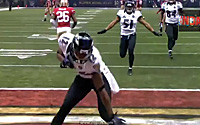Twitter Touchdown: 24 Million Super Bowl Tweets
- by Mark Walsh @markfwal, February 5, 2013
 Twitter emerged as one of the stars of the Super Bowl, with people sending 24.1 million tweets about the game -- up from 13.7 million last year. It’s
likely much of that activity took place on mobile devices through the Twitter app.
Twitter emerged as one of the stars of the Super Bowl, with people sending 24.1 million tweets about the game -- up from 13.7 million last year. It’s
likely much of that activity took place on mobile devices through the Twitter app.
New data from app advertising and analytics firm Flurry shows that mobile app use overall increased 19% during this year’s game compared to last year. The increased penetration of smartphones and tablets in the U.S. over the last year -- to roughly 50% and 20%, respectively -- could explain the increase in app use.
Usage spiked highest (up 17.8%) during the power outage, or Blackout Bowl, at the start of the third quarter as people picked up their devices to send tweets, go on other social platforms, or get information about the delay. Conversely, mobile usage fell nearly 10% during the halftime show when all eyes turned to Beyonce.
Flurry found that app session starts didn’t change much between game play and commercials, with use up only 3.3% during Super Bowl ads. A separate report from digital consulting firm Altimeter Group showed that three-quarters of brands integrated second-screen experiences this year, mostly through Twitter hashtags.
But others like Shazam saw ad integrations fall off from last year’s game, with only 2% of ads tying into the company’s social TV technology.
Comparing app use to Sunday the previous week, the report found that overall app use dipped by less than 5% during the Super Bowl. From this, the firm concluded that consumers are focusing a lot of attention on apps, even when they are sitting in front of the TV.
“This should cause advertisers to question the value of paying a premium for Super Bowl ads when the attention premium they command is eroding,” stated a blog post Tuesday by Mary Ellen Gordon, director, industry insights and analysis at Flurry. In fairness, the company has a vested interest in seeing ad dollars shift from TV to mobile, so the analysis should be taken with that knowledge in mind.
As The Atlantic’s Derek Thompson pointed out in a recent essay, the attention Super Bowl advertisers generate from their ads extends well beyond the 30 seconds a spot runs. “People actually talk about Super Bowl ads, on purpose. They discuss them, analyze them, rank them,” he wrote. “When else do advertisements get their own advertisements?”
In addition, advertisers are trying to capitalize on the two-screen experience to retain viewers’ attention, especially via Twitter. Oreo’s timely Twitter ad during the power outage was retweeted 10,000 times in the first hour and has since generated an avalanche of publicity for the brand.
So it’s hard to maintain, as Flurry does, that the smartphone has “disrupted the holy grail of TV events.” When the price for a 30-second Super Bowl spot rises to $4.5 million next year, will it still be making the same argument?


